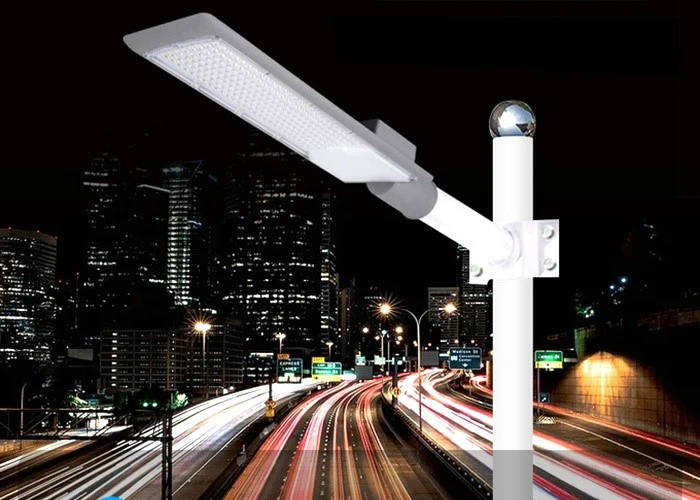Ever wondered why a single burnt-out street light doesn’t turn the entire road dark? The secret lies in the way street lights are wired.
Street lights are wired in parallel circuits, ensuring independent operation and consistent brightness. Unlike series wiring, which can cause system-wide failures, parallel wiring maintains voltage stability and simplifies maintenance.
Understanding how street lights are wired helps cities optimize their lighting infrastructure for reliability, scalability, and cost-effectiveness.
Why Are Street Lights Wired in Parallel?

[Parallel wiring](https://huawei-light.com/solar-street-light/) ensures that each street light functions independently, providing continuous illumination and voltage stability.
1. Continuous Operation & Reliability
| Wiring Type | Failure Impact | Reliability |
|---|---|---|
| Parallel | One failure does not affect others | High |
| Series | One failure disrupts the entire circuit | Low |
- Parallel circuits allow each street light to remain operational even if one light fails.
- Series circuits cause a blackout if one light malfunctions, making them unsuitable for street lighting.
2. [Voltage Consistency](https://huawei-light.com/solar-street-light/) & [Brightness Uniformity](https://huawei-light.com/solar-street-light/)
| Wiring Type | Voltage Distribution | Brightness Consistency |
|---|---|---|
| Parallel | Each light gets full voltage | Uniform brightness |
| Series | Voltage is shared, causing drops | Distant lights dim |
Parallel circuits provide equal voltage to each street light, ensuring uniform illumination throughout the network.
Comparing Parallel vs. Series Wiring in Street Lighting
 | Feature | Parallel Circuits | Series Circuits |
|---|---|---|---|
| Reliability | One failure doesn’t affect others | One failure disrupts the whole circuit | |
| Voltage | Consistent across all lights | Drops along the circuit, dimming distant lights | |
| Maintenance | Easy – Individual light replacement possible | Difficult – Entire line must be managed | |
| Scalability | High – Easy to add/remove lights | Low – Requires redesigning the circuit |
Due to these advantages, parallel wiring is the preferred method for modern street lighting systems.
How Parallel Wiring Affects Voltage & Brightness Consistency

Parallel wiring maintains stable voltage across all lights, ensuring uniform brightness.
1. Understanding Voltage in Parallel Circuits
| Scenario | Voltage Per Light |
|---|---|
| Two lights in parallel | Each receives full voltage |
| Ten lights in parallel | Each still receives full voltage |
- Adding more lights does not reduce brightness, unlike in series circuits, where voltage is shared.
- Parallel wiring allows easy expansion of street lighting infrastructure without affecting performance.
2. Impact of Adding More Street Lights
| Factor | Parallel Circuit | Series Circuit |
|---|---|---|
| Scalability | Easy to expand | Difficult to modify |
| Brightness | Remains uniform | Dims with distance |
Cities use parallel circuits because they allow seamless expansion without sacrificing brightness.
Advantages of Parallel Circuits in Street Lighting

Parallel circuits offer multiple benefits, from easy maintenance to long-term cost-effectiveness.
1. Simplified Maintenance & Troubleshooting
| Feature | Benefit |
|---|---|
| [Independent Operation](https://besenledlight.com/quiz/understanding-street-light-wiring/) | Faulty lights can be replaced without affecting others |
| Quick Repairs | No need to shut down the entire system |
| Smart Diagnostics | Remote monitoring enables faster troubleshooting |
Parallel circuits reduce downtime and simplify street light maintenance.
2. Scalability & Future-Proofing
| Benefit | Impact |
|---|---|
| Easy Expansion | Cities can add more lights without major rewiring |
| Supports LED Upgrades | Energy-efficient LEDs integrate seamlessly |
| [Smart Lighting Integration](https://huawei-light.com/ | Motion sensors & IoT-enabled lights work independently |
Future smart city projects rely on parallel wiring for flexibility and easy upgrades.
3. Cost-Effectiveness Over Time
| Factor | Parallel Wiring Advantage |
|---|---|
| Maintenance Costs | Lower due to independent operation |
| Energy Efficiency | Works well with smart lighting systems |
| [Long-Term Savings](https://huawei-light.com/) | Reduces repair and replacement expenses |
Although initial installation may be costlier than series wiring, parallel circuits save money in the long run.
Why Cities Choose Parallel Circuits for Street Lights

Parallel wiring is the best choice for urban lighting because it ensures:
✅ Uniform Brightness & Safety – Prevents dimming issues and keeps roads well-lit.
✅ Prevention of System-Wide Failures – A single malfunction doesn’t impact the entire circuit.
✅ Seamless Expansion & Maintenance – New street lights can be added with minimal disruption.
✅ Compatibility with Smart City Applications – Supports energy-efficient lighting and IoT integration.
Cities worldwide rely on parallel wiring to maintain efficient and cost-effective street lighting systems.
FAQs: Common Questions About Street Light Wiring
1. Are all street lights wired in parallel?
Yes, to ensure independent operation and reliable illumination.
2. Why aren’t street lights wired in series?
Series circuits cause complete blackouts if one light fails and create voltage inconsistencies.
3. Do parallel circuits increase energy consumption?
No, they optimize energy use by maintaining consistent voltage.
4. Can LED street lights be added to a parallel circuit?
Yes, LED fixtures are easily integrated into existing parallel circuits.
5. How do smart street lights benefit from parallel wiring?
They maintain independent control and enable advanced energy-saving features like motion sensing and dimming.
Conclusion: Parallel Wiring for Reliable & Scalable Street Lighting
✅ Parallel circuits ensure safety, efficiency, and easy maintenance.
✅ Cities worldwide use them to guarantee consistent illumination.
✅ Future innovations, like smart sensors and IoT integration, will further enhance efficiency.
For reliable, scalable, and cost-effective street lighting, parallel wiring is the best approach.







